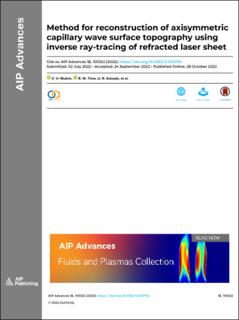| dc.contributor.author | Mukim, Vineet Vishnu | |
| dc.contributor.author | Time, Rune Wiggo | |
| dc.contributor.author | Kanade, Udayan Rajendra | |
| dc.contributor.author | Rabenjafimanantsoa, Herimonja Andrianifaliana | |
| dc.date.accessioned | 2023-01-09T14:19:43Z | |
| dc.date.available | 2023-01-09T14:19:43Z | |
| dc.date.created | 2022-10-29T10:47:09Z | |
| dc.date.issued | 2022 | |
| dc.identifier.citation | Mukim, V. V., Time, R. W., Kanade, U. R., & Rabenjafimanantsoa, A. H. (2022). Method for reconstruction of axisymmetric capillary wave surface topography using inverse ray-tracing of refracted laser sheet. AIP Advances, 12(10), 105322. | en_US |
| dc.identifier.issn | 2158-3226 | |
| dc.identifier.uri | https://hdl.handle.net/11250/3042047 | |
| dc.description.abstract | Capillary waves can be used to measure the fundamental fluid properties such as surface tension as well as, potentially, the viscosity of Newtonian fluids. This requires the measurement of various wave parameters, mainly wavelength, amplitude, and decay coefficient. However, the different scales of magnitudes make it a challenging task. Optical methods are well suited to analyze such problems due to their non-intrusive nature and high dynamic measurement resolution in both space and time. These methods are further categorized as point methods for a single probe measurement and space–time methods for transient measurement of the complete surface. Dynamic space–time methods are preferred despite the associated complex post-processing since they enable reconstruction of the wave surface. Some existing methods are discussed, and an improved method is then proposed to actually solve the associated inverse optics problem. In the method, an axisymmetric wave surface is re-constructed by analyzing the refracted laser sheet. The assumptions, simplifications, and constraints are taken to be compatible with experimental aspects for future validation. It is derived using the fundamental concepts in physics and the only major assumption of the axisymmetric nature of wave surface. The method exploits the underlying symmetry in the topography, making it more versatile, and suited for linear and non-linear capillary waves and waves with planar wavefront. The impact of parameters on the final result is determined through numerical simulations. Very low error (average and maximum) values are observed between reference and reconstructed topography for damped and undamped wave surfaces with a wide range of curvatures. Optimum values of critical parameters and associated reasoning are presented. | en_US |
| dc.language.iso | eng | en_US |
| dc.publisher | AIP Publishing | en_US |
| dc.rights | Navngivelse 4.0 Internasjonal | * |
| dc.rights.uri | http://creativecommons.org/licenses/by/4.0/deed.no | * |
| dc.title | Method for reconstruction of axisymmetric capillary wave surface topography using inverse ray-tracing of refracted laser sheet | en_US |
| dc.title.alternative | Method for reconstruction of axisymmetric capillary wave surface topography using inverse ray-tracing of refracted laser sheet | en_US |
| dc.type | Peer reviewed | en_US |
| dc.type | Journal article | en_US |
| dc.description.version | publishedVersion | en_US |
| dc.rights.holder | The author | en_US |
| dc.subject.nsi | VDP::Matematikk og Naturvitenskap: 400 | en_US |
| dc.source.volume | 12 | en_US |
| dc.source.journal | AIP Advances | en_US |
| dc.source.issue | 10 | en_US |
| dc.identifier.doi | 10.1063/5.0107154 | |
| dc.identifier.cristin | 2066338 | |
| cristin.ispublished | true | |
| cristin.fulltext | original | |
| cristin.qualitycode | 1 | |

